A maternal diet high in n - 6 polyunsaturated fats alters mammary gland development, puberty onset, and breast cancer risk among female rat offspring
- PMID: 9256489
- PMCID: PMC23197
- DOI: 10.1073/pnas.94.17.9372
A maternal diet high in n - 6 polyunsaturated fats alters mammary gland development, puberty onset, and breast cancer risk among female rat offspring
Abstract
We hypothesized that feeding pregnant rats with a high-fat diet would increase both circulating 17beta-estradiol (E2) levels in the dams and the risk of developing carcinogen-induced mammary tumors among their female offspring. Pregnant rats were fed isocaloric diets containing 12% or 16% (low fat) or 43% or 46% (high fat) of calories from corn oil, which primarily contains the n - 6 polyunsaturated fatty acid (PUFA) linoleic acid, throughout pregnancy. The plasma concentrations of E2 were significantly higher in pregnant females fed a high n - 6 PUFA diet. The female offspring of these rats were fed with a laboratory chow from birth onward, and when exposed to 7,12-dimethylbenz(a)anthracene had a significantly higher mammary tumor incidence (60% vs. 30%) and shorter latency for tumor appearance (11.4 +/- 0.5 weeks vs. 14.2 +/- 0.6 weeks) than the offspring of the low-fat mothers. The high-fat offspring also had puberty onset at a younger age, and their mammary glands contained significantly higher numbers of the epithelial structures that are the targets for malignant transformation. Comparable changes in puberty onset, mammary gland morphology, and tumor incidence were observed in the offspring of rats treated daily with 20 ng of E2 during pregnancy. These data, if extrapolated to humans, may explain the link among diet, early puberty onset, mammary parenchymal patterns, and breast cancer risk, and indicate that an in utero exposure to a diet high in n - 6 PUFA and/or estrogenic stimuli may be critical for affecting breast cancer risk.
Figures
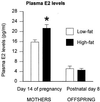
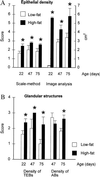

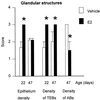
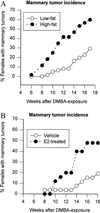
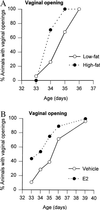
References
-
- Trichopoulos D. Lancet. 1990;355:939–940. - PubMed
-
- Braun M M, Ahlbom A, Floderus B, Brinton L A, Hoover R N. Cancer Causes Control. 1995;6:519–524. - PubMed
-
- Michels K B, Trichopoulos D, Robins J M, Rosner B A, Manson J E, Hunter D, Colditz G A, Hankinson S E, Speizer F E, Willett W C. Lancet. 1996;348:1542–1546. - PubMed
-
- Sanderson M, Williams M, Malone K E, Stanford J L, Emanuel I, White E, Daling J R. Epidemiology. 1996;7:34–37. - PubMed
-
- Villar J, Cogswell M, Kestler E, Castillo P, Menendez R, Repke J T. Am J Obstet Gynecol. 1992;167:1344–1352. - PubMed
Publication types
MeSH terms
Substances
Grants and funding
LinkOut - more resources
Full Text Sources
Medical

